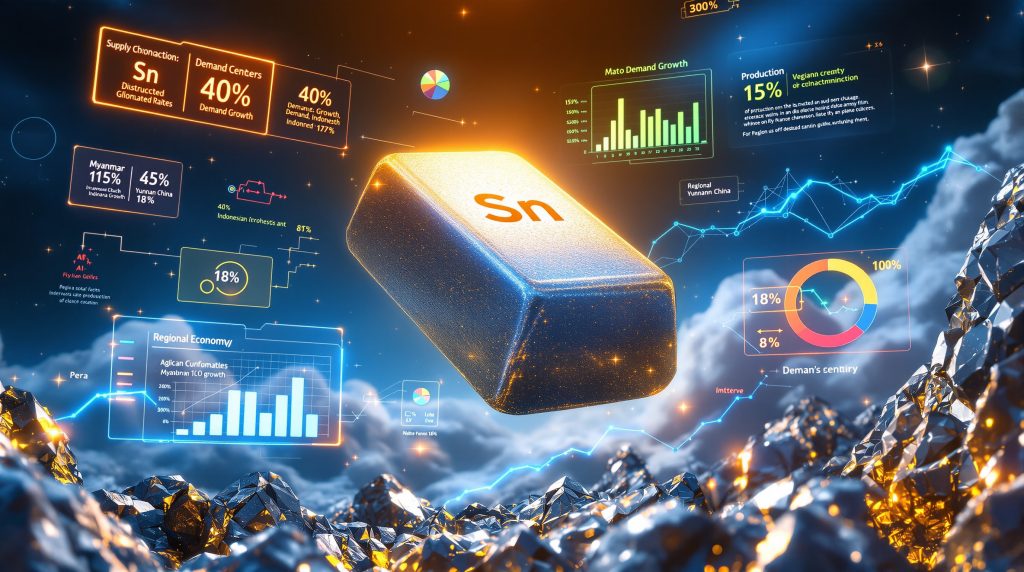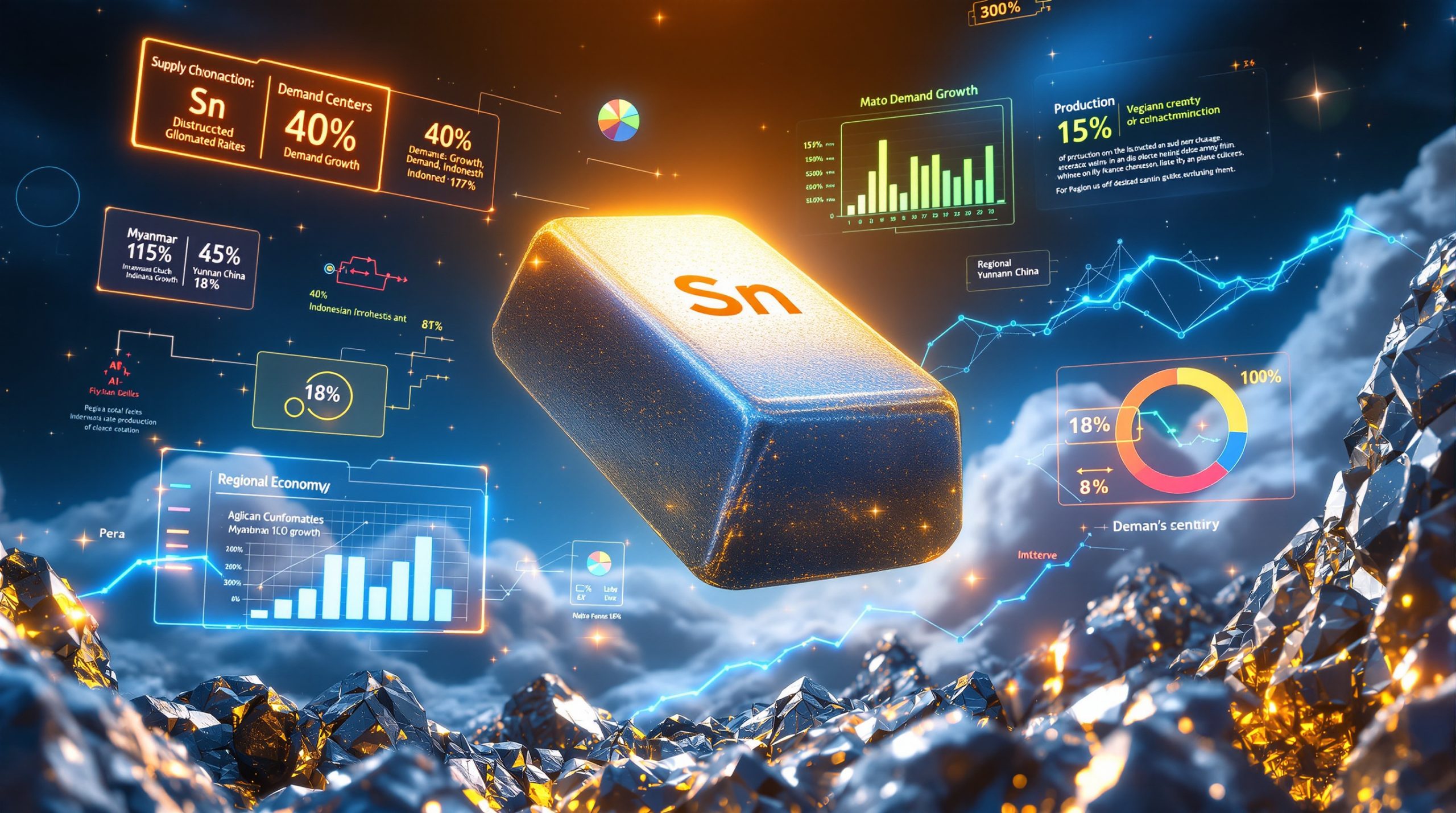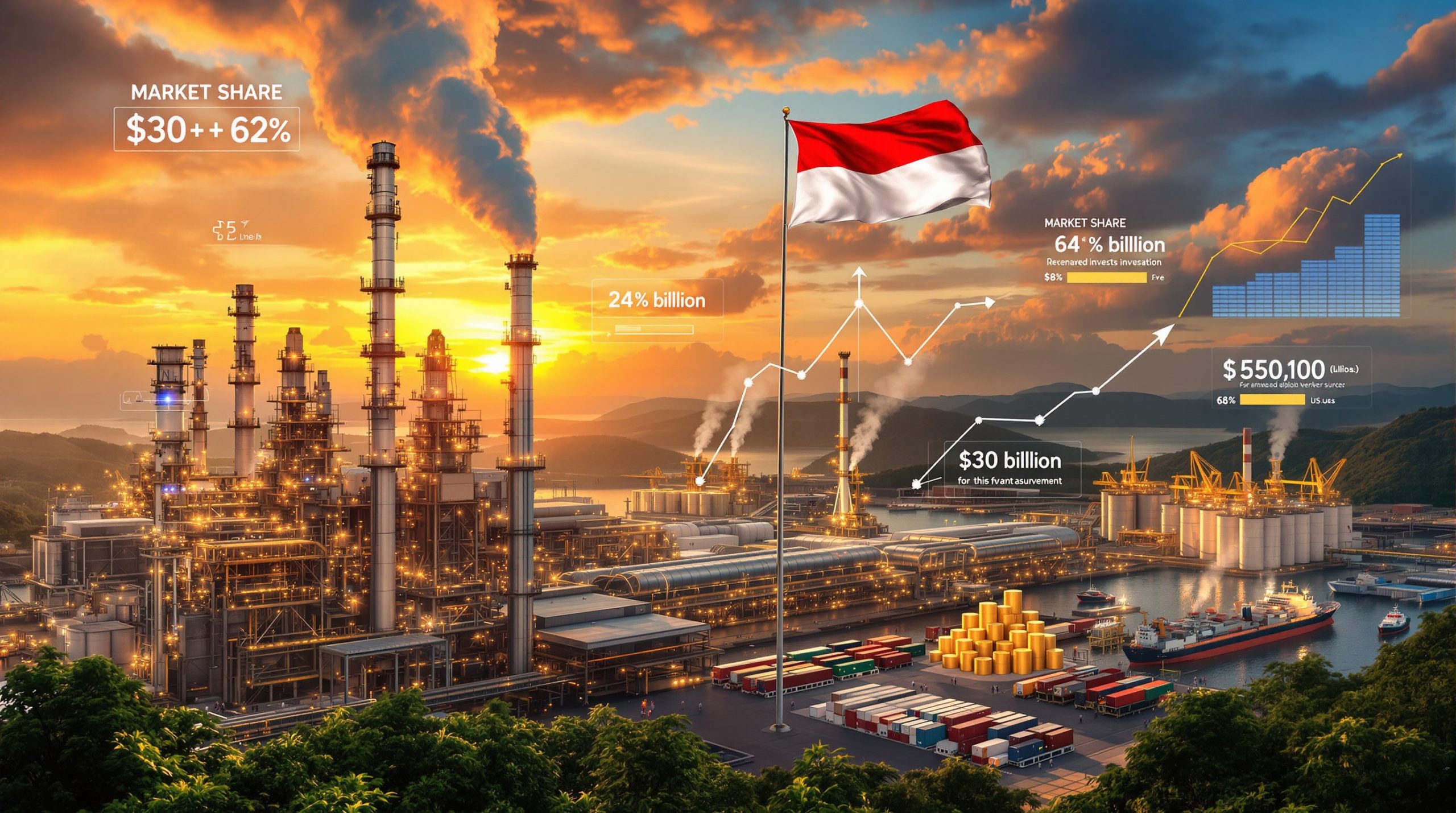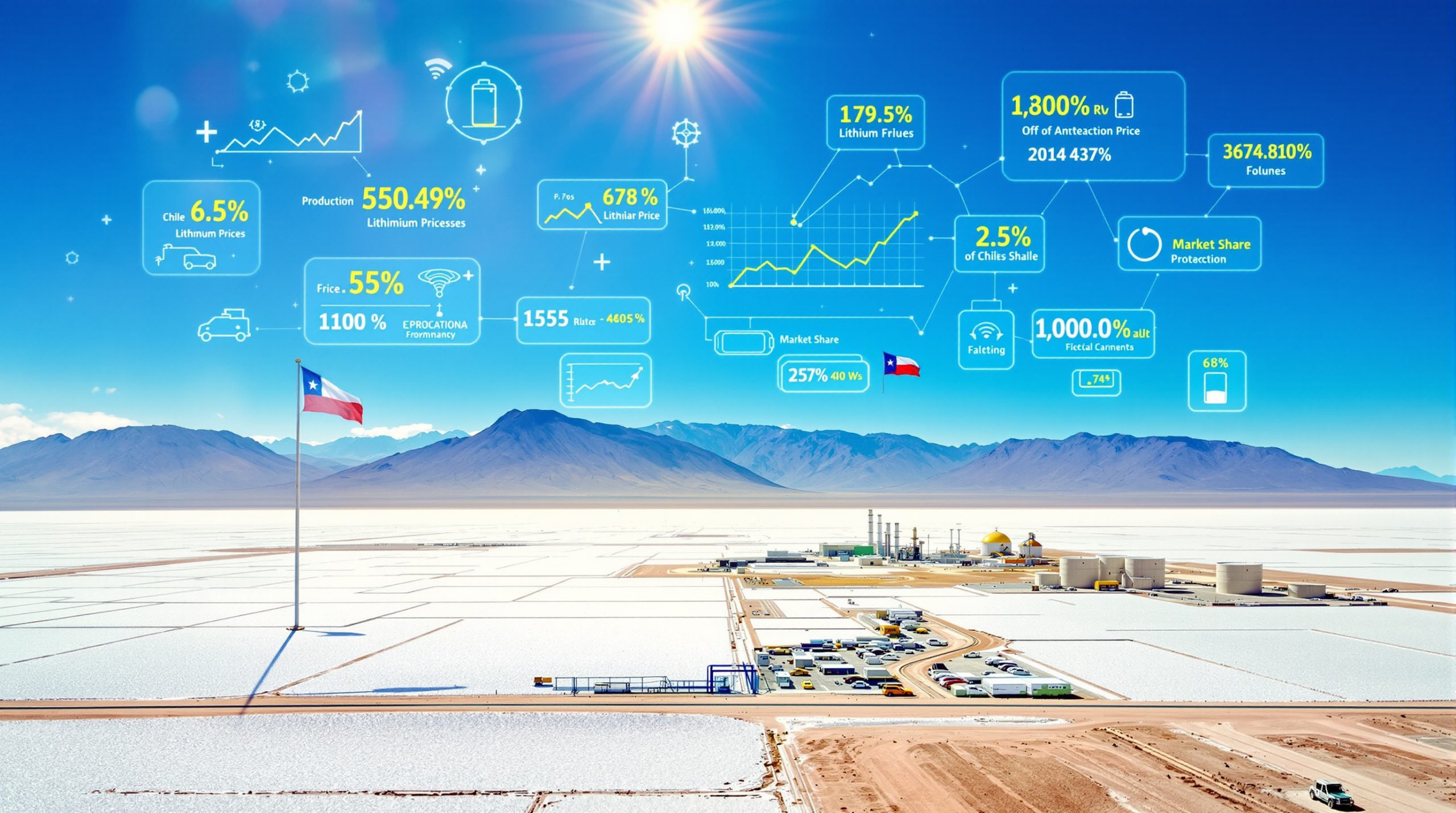How Global Supply Chain Disruptions Are Reshaping Tin Market Fundamentals
The tin market rebound reflects broader shifts in global commodity supply chains, where traditional production centers face mounting operational constraints. Myanmar's political instability has removed approximately 15% of global refined tin capacity, while Indonesia's regulatory tightening has created export bottlenecks affecting 25% of global concentrate supply. Furthermore, the critical minerals strategy implemented by Western governments demonstrates how geopolitical considerations are reshaping metal market fundamentals.
Critical Supply Bottlenecks Across Major Producing Regions
The tin market's structural transformation reflects broader shifts in global commodity supply chains, where traditional production centers face mounting operational constraints. Myanmar's political instability has removed approximately 40,000 tonnes of refined tin capacity from global markets, representing a substantial disruption to global supply chains. This follows the February 2021 military coup, which has severely impacted mining operations and smelter functionality across the country.
Indonesia's regulatory environment has undergone significant tightening, with government crackdowns on illegal mining operations particularly affecting the Bangka and Belitung regions. These regulatory changes have created delayed shipments and export bottlenecks, impacting approximately 25% of global tin concentrate supply. The Indonesian government's intensified enforcement represents a permanent shift toward formalized mining operations, reducing total available supply in the near term.
Regional Supply Disruption Impact Analysis
| Region | Production Share | Key Disruption Factor | Supply Impact |
|---|---|---|---|
| Myanmar | 15% refined tin | Political instability | 40,000 tonnes offline |
| Indonesia | 25% concentrate | Export restrictions | Delayed shipments |
| Yunnan, China | 18% ore supply | Seasonal constraints | Reduced ore availability |
| Peru | 8% global output | Infrastructure damage | 15% capacity reduction |
Yunnan province in China, which historically provides approximately 18% of global tin ore supply, continues experiencing seasonal production constraints that have reduced ore availability for downstream smelters. These constraints reflect both environmental regulations limiting mining activity during certain periods and operational challenges in accessing remote ore deposits.
In addition, Peru's tin production has faced infrastructure-related disruptions, with approximately 15% of capacity reduction due to transportation and logistical challenges affecting remote mining operations. These infrastructure constraints highlight the vulnerability of global tin supply chains to localized operational disruptions.
Inventory Depletion Signals Structural Market Tightening
Global warehouse inventories have contracted to critically low levels, with London Metal Exchange stocks representing less than 2.5 days of global consumption. This inventory-to-consumption ratio indicates the market has transitioned from cyclical weakness to structural deficit conditions, where physical scarcity rather than speculative positioning drives price dynamics. As noted by trading economics, these inventory levels reflect unprecedented market tightness.
The current inventory situation differs fundamentally from previous market tightness episodes. LME stocks represent only formal exchange-listed inventory and exclude significant producer, trader, and consumer stocks held outside the exchange system. However, the dramatic reduction in visible inventory signals broader supply chain tightness across the entire tin ecosystem.
This inventory depletion coincides with reduced investment in tin exploration and development over the past decade, creating a limited pipeline of new projects capable of delivering meaningful production increases within the next five years. The combination of immediate supply disruptions and long-term project scarcity has fundamentally altered market dynamics.
What Role Does Artificial Intelligence Play in Tin Demand Acceleration?
Data Center Infrastructure Driving Exponential Solder Consumption
The artificial intelligence boom has created unprecedented demand for high-performance computing infrastructure, with each GPU-intensive server requiring significantly more tin-based solder than traditional computing equipment. Advanced AI servers incorporate complex power distribution networks and interconnect systems that dramatically increase tin consumption per unit of computing capacity. This technological shift aligns with the broader mining industry evolution 2025 trends affecting commodity markets.
Major cloud providers are expanding data center capacity by approximately 40% annually, driven by exponential growth in AI model training and inference requirements. This expansion translates to substantial increases in tin demand, as each new generation of AI-optimized servers incorporates more sophisticated circuitry requiring specialized soldering applications.
Key Insight: The shift toward AI-intensive computing infrastructure represents a fundamental change in tin consumption patterns, where demand growth becomes tied to technological capability rather than traditional electronics cycles.
Recent developments in AI chip export policies have amplified this demand trajectory. The United States has approved significant volumes of advanced AI chip exports to allied nations, including tens of thousands of semiconductors destined for Saudi Arabia's expanding artificial intelligence infrastructure. This policy shift demonstrates how geopolitical competition in AI development is driving tin demand beyond traditional market cycles.
Semiconductor Manufacturing Renaissance Amplifies Strategic Metal Requirements
Europe's €554 million investment in exascale computing infrastructure demonstrates how geopolitical competition in artificial intelligence is driving tin demand beyond traditional electronics cycles. The Alice Recoque supercomputer project represents Europe's commitment to achieving technological sovereignty in high-performance computing, directly competing with US and Chinese capabilities.
This supercomputer initiative will require specialized soldering applications for millions of processors, advanced cooling systems, and power distribution networks. The construction phase alone represents substantial tin consumption, while the broader European strategy of achieving exascale computing independence signals sustained long-term demand from this sector.
The semiconductor manufacturing renaissance extends beyond individual projects to encompass entire regional strategies for technological independence. European, American, and Middle Eastern governments are actively investing in domestic semiconductor capabilities, creating multiple demand centers that require substantial tin inputs for advanced manufacturing processes. The critical raw materials facility initiatives reflect this strategic approach to securing supply chains.
Why Traditional Electronics Weakness Masks Underlying Structural Strength?
Consumer Electronics Downturn Creates Misleading Demand Signals
While smartphone and consumer appliance sectors have contracted 12% year-over-year, this cyclical weakness obscures robust growth in industrial automation, electric vehicle electronics, and renewable energy applications. The demand composition shift means tin consumption is becoming less sensitive to consumer discretionary spending patterns and more aligned with infrastructure and technology investment cycles.
Traditional electronics manufacturing has faced headwinds from global economic uncertainty, reduced consumer discretionary spending, and inventory adjustments throughout the supply chain. However, these cyclical factors mask the underlying transformation in tin demand composition, where emerging technology applications provide more durable long-term growth prospects.
The bifurcation between legacy electronics and emerging technology applications represents a fundamental shift in tin market dynamics, where structural demand growth offsets cyclical consumer weakness.
This demand transformation creates challenges for short-term market forecasting but strengthens the long-term investment thesis for tin exposure. Industrial automation systems, electric vehicle powertrains, and renewable energy infrastructure require specialized tin applications that are less sensitive to consumer sentiment and more dependent on capital investment cycles and government policy support.
Photovoltaic Solar Installation Boom Drives Industrial Tin Consumption
Global solar panel installations reached record levels in 2024, with each gigawatt of photovoltaic capacity requiring approximately 180 tonnes of tin for interconnect soldering. This application uses tin-based solder to connect silicon cells within modules and to create string interconnections between modules in larger solar installations.
China's 200 GW annual installation target represents a massive scale of renewable energy deployment that translates to approximately 36,000 tonnes of additional tin demand, representing 15% of global refined production. This demand source provides long-term visibility beyond traditional economic cycles, as renewable energy deployment is driven by climate policy commitments and energy security considerations rather than consumer discretionary spending.
The photovoltaic industry's tin consumption extends beyond module manufacturing to include grid interconnection systems, power electronics, and energy storage integration. As solar installations become larger and more sophisticated, the tin intensity per unit of generating capacity has increased, amplifying the total demand impact from renewable energy deployment.
International renewable energy targets suggest this demand source will continue expanding through the decade, providing a structural foundation for tin consumption growth that operates independently of traditional electronics cycles.
How Do Geopolitical Tensions Elevate Tin to Strategic Metal Status?
Technology Export Controls Reshape Global Tin Supply Chain Strategy
The United States' selective approval of AI chip exports to allied nations reflects a broader strategy to maintain technological leadership while securing critical mineral supply chains. This policy shift positions tin as a strategic input for national security infrastructure, elevating its importance beyond traditional industrial applications. Furthermore, the us-china trade war impact on global markets demonstrates how these tensions affect commodity flows.
Recent approvals for tens of thousands of advanced semiconductors to reach Middle Eastern markets, particularly Saudi Arabia, demonstrate how AI competition is driving government-level demand for tin-intensive technologies. These approvals represent a 300% increase in regional semiconductor imports, directly correlating to increased tin consumption in emerging technology markets.
The strategic nature of tin becomes apparent when considering its role in semiconductor manufacturing, data center construction, and advanced computing systems that underpin national technological capabilities. Governments now recognise that securing tin supply chains is essential for maintaining competitiveness in artificial intelligence, quantum computing, and other critical technologies.
Western Economies Prioritise Supply Chain Diversification
European and North American governments are actively seeking non-Chinese tin supply sources, creating premium valuations for projects in stable jurisdictions. This geopolitical realignment has increased strategic investor interest in African and South American tin assets by approximately 60% over the past 18 months.
The shift toward supply chain diversification reflects broader concerns about critical mineral dependency on potentially unstable regions. Western governments have identified tin as essential for technological sovereignty, leading to policy support for domestic and allied-nation tin development projects.
This strategic repositioning creates investment opportunities in exploration and development-stage tin projects located in stable jurisdictions with favourable mining policies. Projects demonstrating high-grade tin resources in countries with strong governance frameworks have attracted increased attention from sovereign wealth funds and strategic investors seeking long-term supply security.
Which Investment Opportunities Emerge from Tin Market Structural Changes?
Early-Stage Exploration Assets Gain Strategic Premium Valuations
The limited global pipeline of high-grade tin discoveries has created scarcity premiums for exploration-stage assets with credible geological signatures. Projects demonstrating polymetallic exposure to tin, copper, and zinc offer diversified exposure to multiple technology-critical metals within single investment vehicles.
Recent drilling results from projects like Rome Resources' Bisie North demonstrate the potential for resource expansion beyond initial geological targets. The company's exploration in the Democratic Republic of Congo has revealed tin mineralisation extending beyond known soil anomalies, suggesting larger mineral systems than initially anticipated.
Investment Thesis Framework for Tin Exposure
| Investment Category | Risk Profile | Potential Returns | Time Horizon |
|---|---|---|---|
| Producing Mines | Low-Medium | 15-25% annually | 2-3 years |
| Development Projects | Medium-High | 50-150% total | 3-5 years |
| Exploration Assets | High | 200-500% potential | 5-7 years |
| Physical Tin ETFs | Low | Price correlation | 1-2 years |
The exploration stage offers the highest potential returns but requires careful evaluation of geological merit, management capabilities, and jurisdictional stability. Projects with proximity to producing mines benefit from established infrastructure and validated geological models, reducing development risk and timeline uncertainty.
Polymetallic Systems Provide Risk-Adjusted Technology Metal Exposure
Tin-copper-zinc mineral systems offer investors exposure to multiple critical metals through single project investments, reducing commodity-specific risk while maintaining alignment with electrification and digitalisation trends. This diversification strategy becomes increasingly valuable as technology supply chains require multiple specialised metals simultaneously.
Polymetallic projects benefit from operational synergies where shared infrastructure and processing facilities reduce per-metal development costs. The presence of copper and zinc alongside tin provides cash flow diversification and reduces dependence on single commodity price cycles.
Geological controls in these systems, particularly shear zone-hosted mineralisation, often create predictable resource extension opportunities. Understanding these structural controls allows investors to evaluate expansion potential and resource growth probability when assessing early-stage projects. Furthermore, ai transforming mining technologies are improving exploration efficiency and discovery rates.
The Democratic Republic of Congo has emerged as a significant jurisdiction for polymetallic tin projects, with successful operations like Alphamin's Bisie mine demonstrating that well-managed projects can deliver strong returns despite historical concerns about regional stability.
What Economic Indicators Signal Long-Term Tin Market Transformation?
Price Stability Above Critical Thresholds Indicates Market Maturation
Tin's ability to maintain prices above $30,000/tonne despite traditional electronics weakness demonstrates the market's transition from cyclical volatility to structural support. This price floor reflects recognition amongst market participants that supply constraints are permanent rather than temporary phenomena.
The recent stabilisation above 290,000 yuan/mt on the Shanghai Futures Exchange represents more than technical support; it indicates fundamental shifts in market dynamics where structural demand provides price resilience independent of traditional consumption patterns. This pricing behaviour suggests the market is transitioning from cyclical industrial commodity to strategic technology input.
Historical price volatility in tin markets reflected the dominance of consumer electronics demand, which created pronounced boom-bust cycles aligned with technology product cycles. The current price stability despite electronics weakness indicates that emerging demand sources provide more consistent consumption patterns. According to mining news analysis, this represents a fundamental shift in the tin market rebound dynamics.
Investment Capital Allocation Shifts Toward Critical Minerals
Institutional investors have increased allocations to technology-critical metals by 180% since 2022, with tin representing a key component of strategic mineral portfolios. This capital reallocation reflects growing awareness that digital economy growth requires secure access to specialised industrial metals.
Sovereign wealth funds and strategic investors have particularly increased focus on tin assets, driven by government-level recognition that secure tin supply chains are essential for technological competitiveness. This institutional interest creates improved access to capital for development-stage tin projects in stable jurisdictions.
The shift in capital allocation patterns extends beyond financial investors to include technology companies seeking vertical integration and supply chain security. Major semiconductor manufacturers and cloud providers are exploring strategic investments in tin supply chains to ensure adequate raw material availability for expanding operations.
How Should Investors Position for the Next Phase of Tin Market Evolution?
Supply-Demand Imbalance Creates Multi-Year Investment Opportunity
The International Tin Association's forecast of 40% demand growth by 2030, combined with limited new production capacity, creates a structural deficit scenario lasting through the decade. This extended supply-demand imbalance provides favourable conditions for both producing assets and development-stage projects with credible timelines to production. Consequently, the tin market rebound is expected to extend well beyond current price levels.
The demand growth projection encompasses artificial intelligence infrastructure, renewable energy deployment, electric vehicle adoption, and industrial automation expansion. These demand drivers operate independently of traditional economic cycles, providing more predictable consumption growth than historical tin markets dominated by consumer electronics.
Limited new mine development reflects both the scarcity of high-grade tin deposits and the extended timelines required for project permitting and construction. This supply constraint creates sustained pricing support and attractive investment returns for companies capable of delivering new production capacity within the forecast deficit period.
Technology Sector Growth Provides Demand Visibility Beyond Economic Cycles
Unlike traditional industrial metals, tin's growing dependence on artificial intelligence, renewable energy, and semiconductor manufacturing creates demand visibility that extends beyond economic cycles. This structural demand foundation reduces investment risk associated with cyclical commodity exposure while providing alignment with long-term technological and policy trends.
Government commitments to renewable energy deployment, artificial intelligence development, and semiconductor manufacturing independence provide policy-driven demand support that operates independently of private sector investment cycles. These commitments create multi-year demand visibility for tin consumption in strategic applications.
The technology sector's capital intensity and long development timelines mean that tin demand from these applications provides sustained consumption patterns rather than the volatile demand cycles characteristic of consumer electronics markets.
Featured Snippet Optimisation:
What drives the tin market rebound in 2025? The tin market rebound is driven by three primary factors: supply disruptions in Myanmar and Indonesia removing 40,000+ tonnes of capacity, exponential demand growth from AI infrastructure requiring advanced soldering applications, and strategic government investments in technology sovereignty creating long-term demand visibility beyond traditional electronics cycles.
Conclusion – Tin's Transformation from Industrial Metal to Strategic Asset
The tin market's evolution from cyclical industrial commodity to strategic technology input represents a fundamental shift in how investors should evaluate critical mineral exposure. Supply-side constraints, combined with artificial intelligence-driven demand acceleration, have created a multi-year investment opportunity characterised by structural deficits and premium valuations for high-quality assets.
This transformation extends beyond short-term price movements, reflecting deeper changes in global technology infrastructure requirements and geopolitical competition for semiconductor manufacturing capabilities. Supply disruptions in Myanmar and Indonesia, combined with limited global exploration success, have created permanent supply constraints that coincide with exponential demand growth from emerging technology applications.
Investors positioned early in this transition through diversified exposure to producing mines, development projects, and exploration assets are best positioned to benefit from tin's strategic repricing. The intersection of artificial intelligence deployment, renewable energy expansion, and geopolitical competition for technology supremacy creates multiple demand drivers that operate independently of traditional economic cycles.
The tin market rebound reflects these structural changes rather than cyclical recovery, positioning the metal as an essential input for the digital economy transformation currently underway across developed and emerging markets. As governments prioritise technology sovereignty and supply chain security, tin's strategic importance will continue expanding beyond its traditional industrial applications.
Ready to capitalise on the next major mineral discovery?
Discovery Alert instantly alerts investors to significant ASX mineral discoveries using its proprietary Discovery IQ model, turning complex mineral data into actionable insights. Understand why historic discoveries can generate substantial returns by exploring Discovery Alert's dedicated discoveries page, showcasing historic examples of exceptional outcomes, and begin your 30-day free trial today to position yourself ahead of the market.




